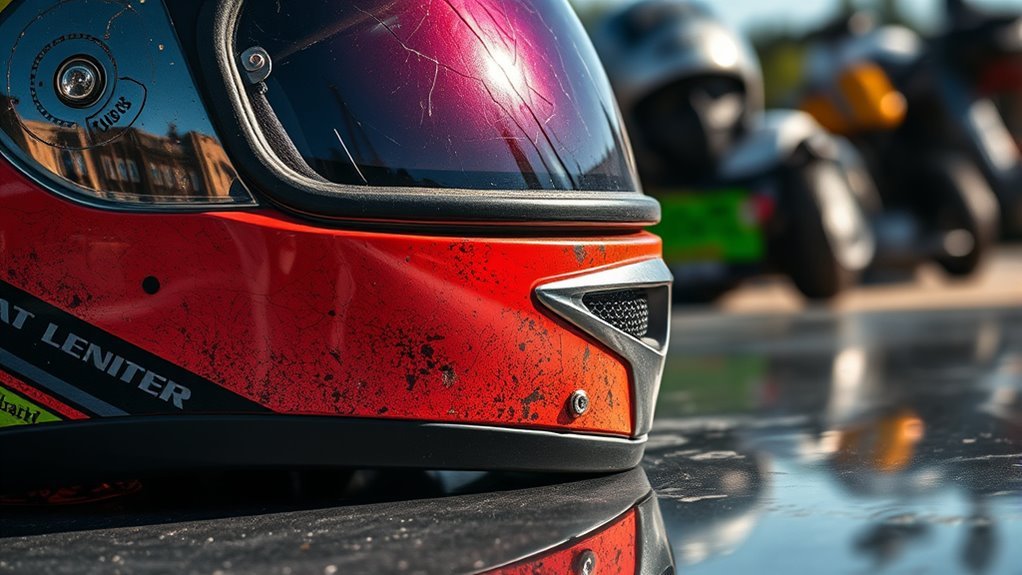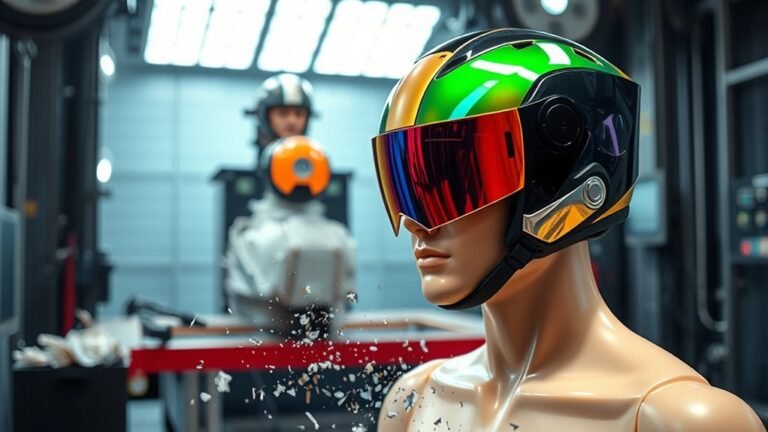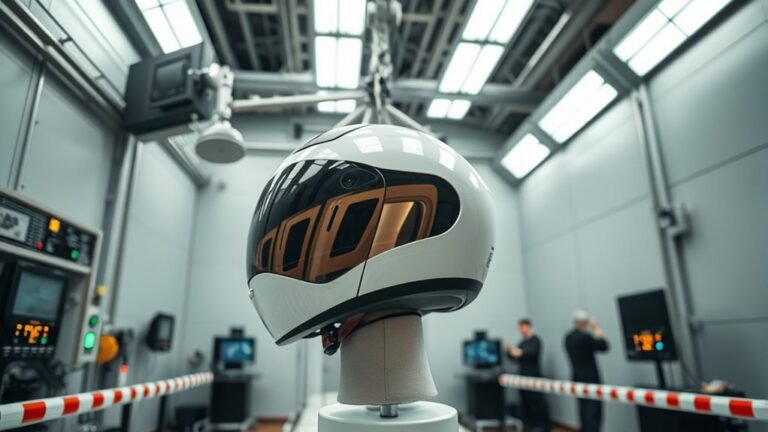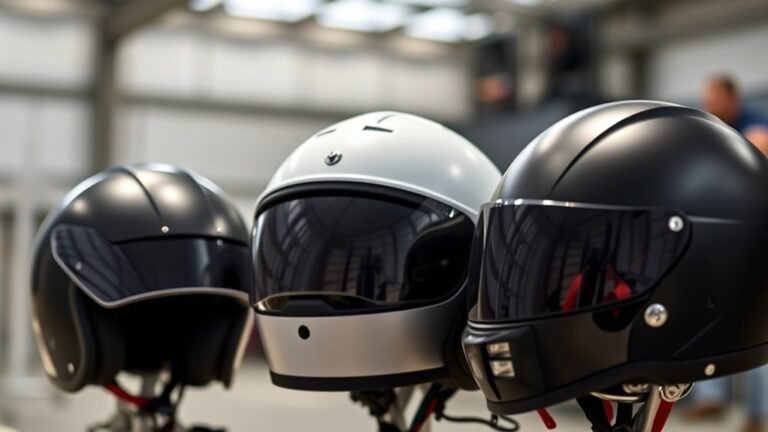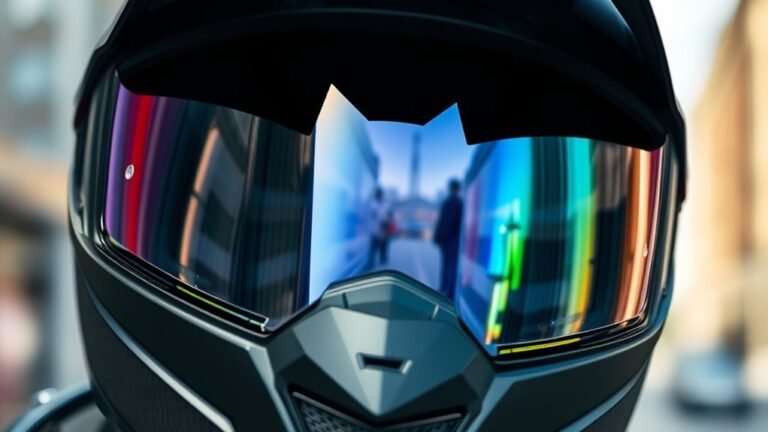Why Your Motorcycle Helmet Should Be Replaced Regularly
Your motorcycle helmet needs regular replacement because its materials degrade over time, even if it looks fine. UV exposure, temperature changes, and impacts can compromise its protective abilities. After five years, helmets should be replaced, regardless of visible wear. Signs like cracks, a loose fit, or discoloration indicate it’s time for a new helmet. Prioritizing your safety is essential. Discover more about helmet technology and maintenance to guarantee you’re always protected on the road.
The Lifespan of a Motorcycle Helmet
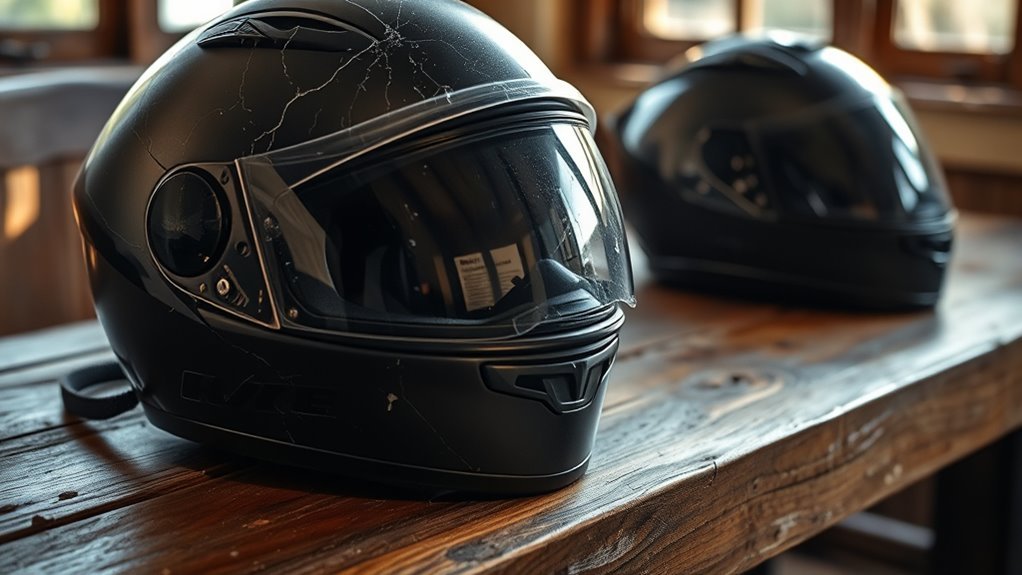
When you purchase a motorcycle helmet, it’s crucial to understand that its lifespan is limited, even if it appears undamaged. The materials used in helmet construction, such as polycarbonate, fiberglass, and carbon fiber, can degrade over time due to environmental exposure, UV light, and temperature variations. Helmet design also plays a critical role; the impact-absorbing foam inside can compress after repeated use, diminishing its protective capabilities. Manufacturers generally recommend replacing your helmet every five years, regardless of visible wear. This timeframe guarantees that the helmet maintains peak performance in safeguarding your freedom on the road. Regularly evaluating your helmet’s condition and being aware of its lifespan can enhance your safety and riding experience.
Signs It’s Time to Replace Your Helmet
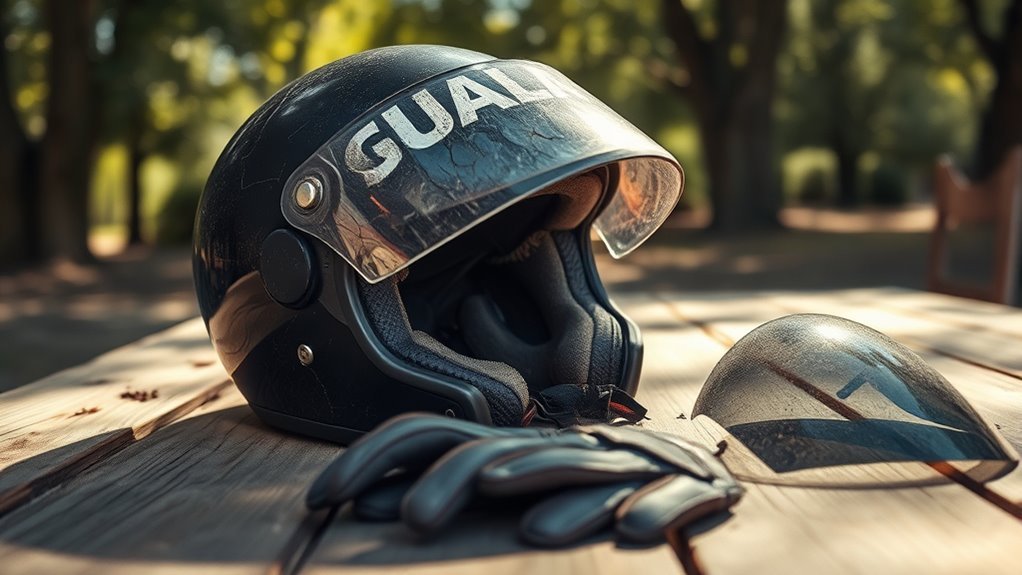
Understanding the lifespan of your motorcycle helmet helps you recognize when it’s time for a replacement. Here are some key signs to look out for:
| Sign | Description | Action Required |
|---|---|---|
| Visible Damage | Cracks, dents, or deep scratches | Replace immediately |
| Outdated Materials | Helmets over five years old | Replace regardless of condition |
| Loose Fit | Padding worn down or missing | Replace if unsafe |
| Faded Interior | Significant discoloration | Replace for hygiene |
If you notice any of these signs, it’s essential to prioritize your safety and freedom on the road by investing in a new helmet. Don’t compromise your protection; your adventures deserve the best gear.
The Impact of UV Exposure on Helmet Integrity
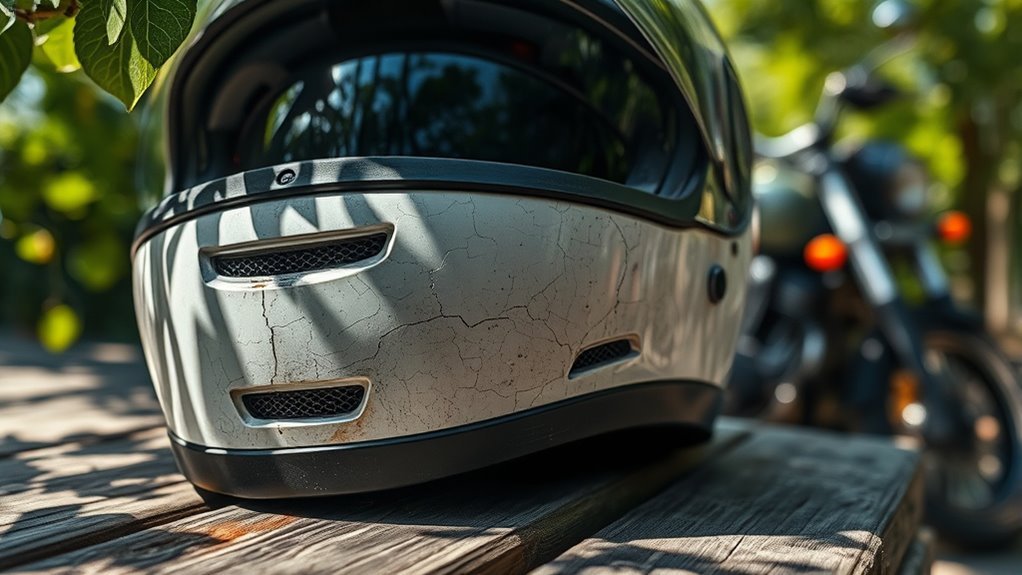
Although helmets are designed to withstand various environmental conditions, prolonged exposure to ultraviolet (UV) rays can greatly degrade their structural integrity. UV degradation affects the helmet materials, such as the outer shell and inner foam, compromising their effectiveness in an accident. Over time, you might notice fading colors or brittleness, signals that the helmet can no longer provide ideal protection. This deterioration can happen even if the helmet appears visually intact. To guarantee your safety and freedom on the road, it’s vital to regularly inspect your helmet for signs of UV damage and replace it as needed. Remember, your helmet is your first line of defense, and maintaining its integrity is essential for your motorcycle riding experience.
Advances in Helmet Technology
As helmet technology evolves, manufacturers are incorporating innovative materials and designs that greatly enhance rider safety. Today’s helmets often feature smart materials, which adapt to varying conditions to provide superior protection. These materials can stiffen upon impact, considerably improving impact absorption, and then return to a flexible state for comfort during rides. Additionally, advanced ventilation systems are being integrated, ensuring you stay cool without compromising safety. The use of lighter materials reduces fatigue on long rides, allowing you to enjoy the open road for longer periods. With these advancements, you’ll find helmets that not only protect but also enhance your riding experience, making freedom on two wheels safer than ever. Embrace the evolution and ride with confidence!
The Importance of Proper Helmet Fit
A proper helmet fit is essential for maximizing safety during motorcycle rides. When a helmet fits correctly, it guarantees compliance with safety standards and enhances comfort and stability. Without the right fit, even the most advanced helmet technology can fail to provide the protection you need.
Ensuring Safety Standards
When choosing a motorcycle helmet, guaranteeing a proper fit is crucial for maximizing safety and effectiveness. A helmet that doesn’t fit correctly can compromise your protection, even if it meets safety regulations. It’s essential to understand that helmet materials, like polycarbonate and fiberglass, play roles in shock absorption and durability. A snug fit allows these materials to perform effectively during an impact, reducing the risk of injury. Always check for certification labels to verify your helmet complies with safety standards. Remember, a loose helmet can shift during a ride, increasing the chances of a serious injury. So, prioritize fit and material quality when selecting your helmet; your freedom on the road depends on it.
Comfort and Stability
While comfort might seem secondary to safety, the right fit is essential for both. A well-fitted helmet guarantees stability during your ride, preventing unnecessary movement that could distract you. Look for helmets designed with high-quality cushioning materials, as they enhance comfort and reduce pressure points. Additionally, consider airflow design; proper ventilation keeps you cool on long journeys, allowing for a more enjoyable experience.
| Feature | Benefits | Importance |
|---|---|---|
| Cushioning Materials | Enhances comfort | Reduces pressure points |
| Airflow Design | Provides ventilation | Prevents overheating |
| Proper Fit | Guarantees stability | Improves focus |
| Lightweight | Reduces fatigue | Increases ride time |
| Adjustable Straps | Customizable fit | Enhances security |
Embrace the freedom of the road with the right helmet fit!
Understanding Helmet Certifications and Standards
Understanding helmet certifications and standards is essential for ensuring your safety while riding. Helmet certification involves rigorous testing to meet established safety standards, such as DOT, Snell, and ECE. These organizations evaluate helmets for impact resistance, penetration, and retention system effectiveness, confirming they can protect you in a crash. When you choose a helmet, look for these certifications prominently displayed, as they indicate that the helmet has undergone extensive testing. Riding with a certified helmet not only enhances your freedom on the road but also greatly reduces the risk of severe injury. Always prioritize safety standards; they’re your best ally in enjoying the ride while safeguarding your well-being. Remember, a certified helmet is not just gear; it’s your shield.
The Role of Regular Inspections in Helmet Maintenance
To guarantee your helmet continues to provide ideal protection, regular inspections are essential. Visual inspections help you identify any signs of wear, damage, or degradation that could compromise safety. This routine maintenance can extend the lifespan of your helmet and make certain it remains reliable.
| Inspection Type | Frequency |
|---|---|
| Visual Inspection | Before each ride |
| Padding Check | Monthly |
| Strap and Buckle Test | Every 3 months |
Frequently Asked Questions
Can I Clean My Helmet With Soap and Water?
Yes, you can clean your helmet with soap and water, but it’s essential to use gentle, non-abrasive soap. In fact, regular helmet maintenance can extend the life of your gear considerably—up to 30% longer! For effective cleaning techniques, mix mild soap with warm water and use a soft cloth. Avoid harsh chemicals, as they can damage the materials. Keeping your helmet clean not only enhances comfort but also maintains its protective qualities.
Are There Specific Storage Conditions for Helmets?
Yes, there are specific storage conditions for helmets. You should store your helmet in a cool, dry place, away from temperature sensitivity extremes. Avoid areas with high moisture exposure, as damp environments can damage the helmet’s materials. Keep it out of direct sunlight to prevent degradation of the outer shell. Proper storage guarantees your helmet maintains its protective features, allowing you to ride freely and confidently on the open road.
How Do I Know My Helmet Size?
To determine your helmet size, start by measuring the circumference of your head just above your eyebrows with a flexible tape measure. Use this measurement to refer to sizing charts provided by manufacturers, as sizes can vary between brands. A proper helmet fitting should feel snug but not uncomfortable, with no pressure points. Remember, an accurate fit is essential for safety and freedom on the road, so take your time to find the right size.
Does Helmet Color Affect Safety?
Just like a beacon in the night, your helmet color can greatly impact safety. Bright colors enhance helmet visibility, making you more noticeable to other drivers. Color psychology suggests that vivid hues, such as yellow or orange, can attract attention more effectively than muted tones. While the primary function of a helmet is protection, choosing the right color can elevate your safety on the road, ensuring you stay seen and safe while enjoying your ride.
Can I Customize My Helmet’s Interior Padding?
Yes, you can customize your helmet’s interior padding. Many manufacturers offer various padding options to enhance comfort and fit. You can choose from different interior materials, like memory foam or gel, which can provide better support and reduce pressure points during long rides. Just make certain that any modifications maintain safety standards and don’t compromise the helmet’s integrity. Personalizing your helmet can markedly improve your riding experience while keeping it functional.
